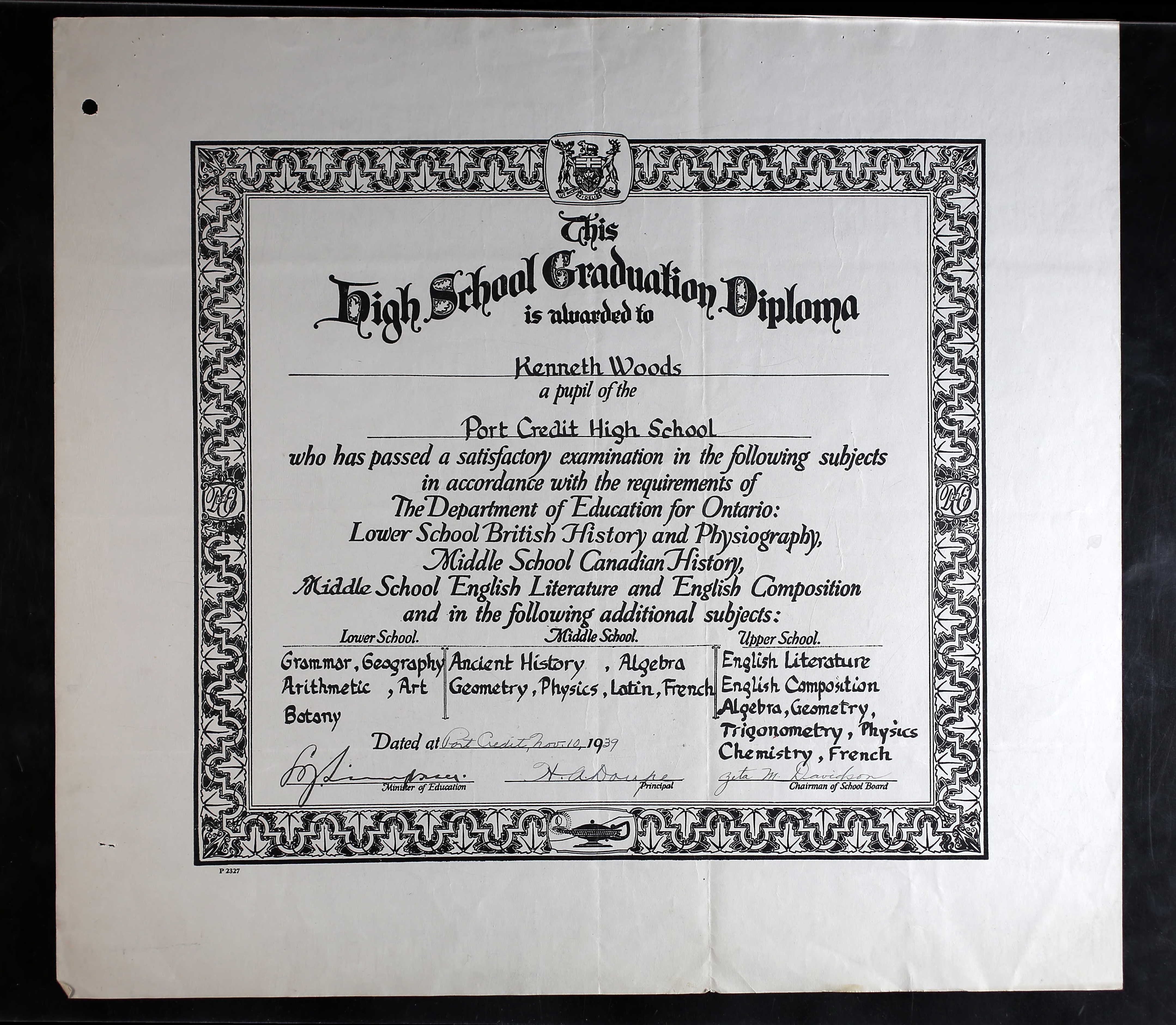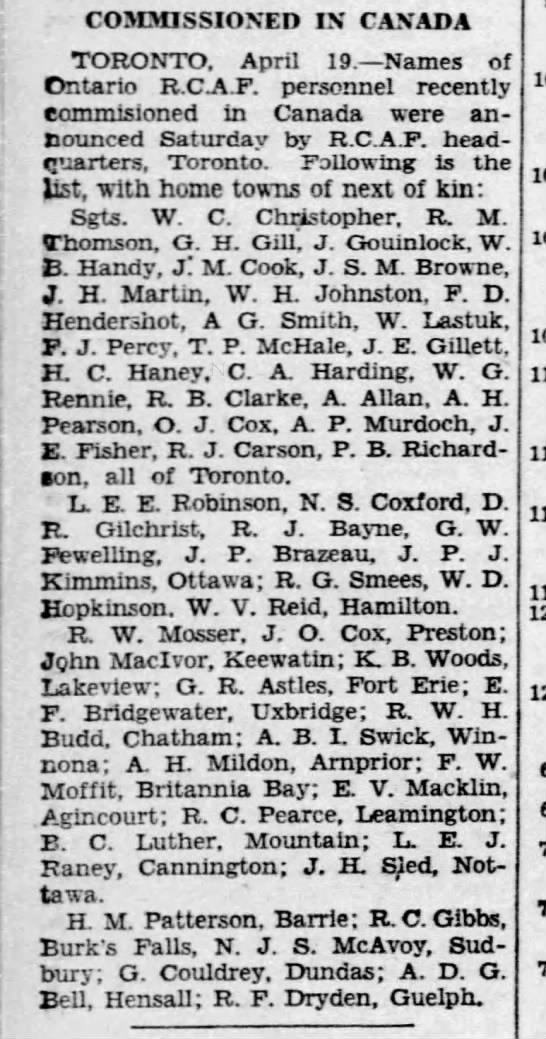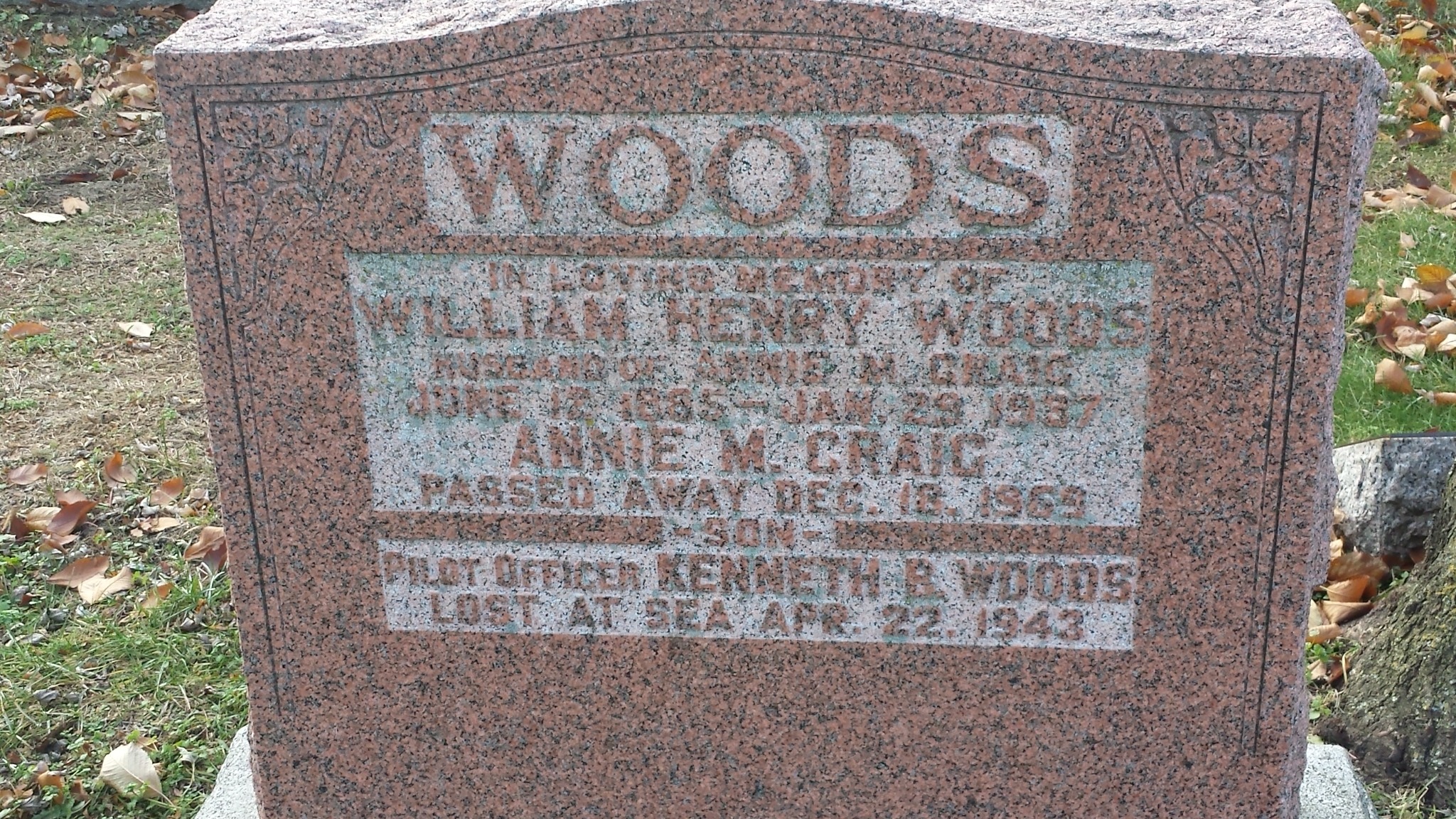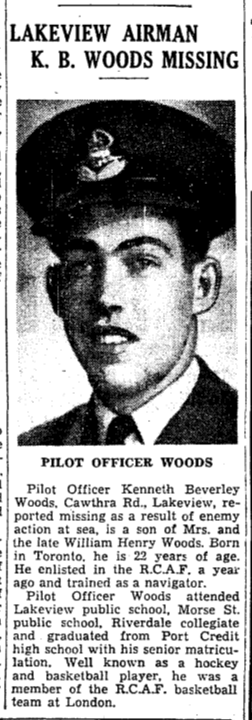






October 28, 1920 - April 22, 1943







Kenneth Beverley Woods, born in Toronto, was the son of William Henry Woods (1885-1937), brass moulder, and his wife Anne (aka Annie) May (nee Craig) Woods (d. 1969) of Lakeview, Ontario. Kenneth had two sisters: Dolly May Ritchie, 27, and Jean Eleanore Woods, 24, as of 1944. The family was Presbyterian.
Kenneth enlisted with the Canadian Army on May 15, 1942. At that time, he stood 6’ ½” tall. And weighed 145 pounds. He had a fair complexion, brown eyes and black hair. Two weeks later, he was discharged from the army so he could enlist in the RCAF. On his interview sheet: “Good appearance, pleasant, senior matriculation (Grade XIII) 1939, well qualified and has keen desire to fly. Organized, courageous, good type.”
He had been working as a laboratory assistant (1940-1942) at St. Lawrence Starch Co. prior to enlistment. He enjoyed baseball, basketball, and hockey. After the war, he wanted to pursue mechanical or chemical engineering.
On May 30, 1942, Kenneth was accepted by the RCAF. He started his journey through the BCATP at No. 1 Manning Depot, Toronto May 30 until July 23, 1942.
He was sent to No. 8 SFTS Moncton, NB from July 24 to September 12, 1942 until he could begin his aircrew training, which he started at No. 3 ITS, Victoriaville, Quebec on September 13 until November 21, 1942. “Retiring, intelligent, an excellent student. Solid and dependable. Good Service spirit. Alternative recommendation: Air Bomber.” He was 16th out of 130 in his class with a 93%.
From there, he was sent to No. 4 AOS, London, Ontario November 22, 1942 until April 3, 1943. On January 24, 1943, he was AWL from 0130 hours to 0515 hours, absent three hours and 45 minutes. He was confined three days to barracks. “Learns easily. Accurate charts and good log form. Mature and reliable.” He was 8th out of 23 in his class and earned 77%. He was unsuitable as an instructor, but suitable to hold a commissioned rank.
He received his Air Observer’s Badge on March 19, 1943 as well as his commission. He was a navigator.
Kenneth had fifteen or sixteen War Savings Certificates in $5 denominations and a life insurance policy with Metropolitan Life Insurance Co. He had been supporting his mother with $80 per month including his board while he worked as a lab assistant, as he was the only child able to offer this support.
Kenneth traveled to Halifax and was taken on strength at the Y Depot April 4, 1943. By April 13th, he was attached to the RAF Trainees’ Pool, awaiting transportation overseas.<'p>
On April 22, 1943, Kenneth was aboard the Amerika, British Motor merchant ship. It was on its way from Halifax, Nova Scotia to Liverpool. It was torpedoed as the ship was heading to Britain. It was a straggler in convoy HX-234. Thirty-seven men, all officers in the RCAF, were presumed missing as a result of enemy action at sea; sixteen were landed at a British port after their ship was sunk by U-306, south of Cape Farewell, off Greenland. Forty-two crew members and seven gunners were also amongst those who were lost. The master, Christian Nielsen, 29 crewmembers, eight gunners, and sixteen passengers were picked up by the HMS Asphodel, and landed at Greenock. General cargo, including metal, flour, meat and 200 bags of mail were also lost.
On May 25, 1943, Mrs. Woods received her son’s Commission Script.
In late June 1943, a letter arrived addressed to Mrs. Woods from F/L Gunn, RCAF Casualties Officer, for Chief of the Air Staff: "Since my letter of May 6th, no additional news has been received. Attached is a list of the names and next-of-kin of sixteen Royal Canadian Air Force officers who embarked on the same ship as your son and following enemy action at sea were safely landed in the United Kingdom. The following official statement was made in the House of Commons....’I have been in receipt of communications from a number of members of this house and from people outside with reference to rumours regarding the recent loss of a number of members of the RCAF by the sinking of a ship in the north Atlantic and I desire to make the following statement on the facts. The vessel in question was a ship of British registry of 8,862 tons, designed for peace-time carriage of both passengers and freight, and having a speed of fifteen knots. She carried a crew of 86 and the passenger accommodation consisted of 12 two-berth rooms with bath and 29 other berths, providing cabin accommodations for 53 passengers. She was fitted with lifeboat capacity for 231 and travelled in naval convoy. Under the recently revised regulations agreed to by the United States authorities, the joint United Kingdom and United States shipping board, the Admiralty, the Air Ministry and the Canadian authorities, a vessel of this description travelling in convoy is permitted to embark as crew and passengers a maximum of 75% of the lifeboat capacity. The lifeboat capacity as stated above was 231, 75% of which is 173. Personnel on board consisted of the crew of 86, and RCAF personnel numbering 53, a total of 139, well within the prescribed limits. Because of the superior type of available passenger accommodation, the speed of the ship and the provision of naval convoy, the offer of the entire available space to the RCAF was immediately accepted. Rumours to the effect that this was a slow freighter not suitable for passenger accommodation are, of course, not in accord with the facts. Every precaution was taken to safeguard the lives of these gallant young men. It should be pointed out that on account of the serious shipping shortage every available berth on such ships must be used, and had the space not been taken up by the RCAF officers of the other arms of the services would have been placed on Board. It should also be stated again that the submarine is still the enemy’s most powerful weapon and that the Battle of the Atlantic is not yet won. Any ocean trip today in any part of the world is fraught with danger and I think I safely say that our record in transporting our soldiers and airmen to the United Kingdom is one of while we may all be proud. No one deplores more than I do the loss of 37 of the finest of our young men who gave their lives for their country as surely as if they had done so in actual combat with the enemy, and I extend my deepest sympathy to their loved ones in their bereavement.’ If further information becomes available, you are to be reassured it will be communicated to you at once. May I again extend to you my sincere sympathy in this time of great anxiety."
In January 1944, Mrs. Woods received a letter from Air Marshall Robert Leckie informing her that Kenneth was now officially presumed to have died on Active Service on April 22, 1943.
In October 1955, Mrs. Woods received a letter from W/C Gunn stating since that Kenneth had no known grave, Kenneth’s name would appear on the Ottawa Memorial.